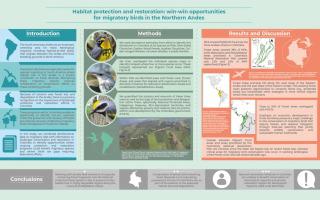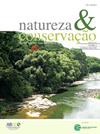Habitat protection and restoration: Win–win opportunities for migratory birds in the Northern Andes
Abstract
Identifying strategies that offer co-benefits for biodiversity protection, forest restoration and human well-being are important for successful conservation outcomes. In this study, we identified opportunities where forest restoration and rehabilitation programs in Colombia also align with priority areas for the conservation of Neotropical migratory birds. We used citizen science eBird-based abundance estimates to define regions with the highest richness of Neotropical migratory birds of conservation concern at montane elevations in Colombia and aligned these high richness areas with domestic initiatives for forest protection (Forest Areas), restoration (Restoration Areas) and rehabilitation (Rehabilitation Areas). We quantified the location and amounts of these three areas as well as the type of land protection and designation within them, specifically, National Protected Areas, Indigenous Reserves, Afro-descendent territories, and regions affected by poverty and violence that are prioritized for rural development by the Colombian government in Post-conflict Territorially Focused Development Programs (PDET). Almost half of Forest Areas overlapped with PDETs where goals for economic development present a risk of forest loss if not done sustainably. There was a 20% overlap between Forest Areas and Afro-descendant territories and indigenous reserves; most of this overlap was outside of established protected areas thus presenting an opportunity for community forest conservation that benefits migratory birds. We found an alignment of less than 6% between migrant bird focal areas and the priority Restoration and Rehabilitation Areas identified by the Colombian National Restoration Plan indicating less opportunity for these programs to simultaneously benefit Neotropical migrant species. Our approach highlights that timely and efficient conservation of declining migrants depends on identifying the regions and strategies that incorporate local communities as part of the solution to forest loss and degradation in Colombia.


 求助内容:
求助内容: 应助结果提醒方式:
应助结果提醒方式:


